Services on Demand
Journal
Article
Indicators
Related links
-
 Cited by Google
Cited by Google -
 Similars in Google
Similars in Google
Share
South African Journal of Industrial Engineering
On-line version ISSN 2224-7890
S. Afr. J. Ind. Eng. vol.35 n.2 Pretoria Aug. 2024
https://doi.org/10.7166/35-2-2911
CASE STUDIES
Project management maturity and its impact on perceived project success: a case study
E. Burger; S. Pretorius; H. Steyn
Department of Engineering and Technology Management, University of Pretoria, Pretoria, South Africa
ABSTRACT
A notion exists that organisations with higher levels of project management maturity execute projects more effectively and efficiently and so have a higher probability of achieving project success. This paper reports on a single case study that measured the project management maturity of four project management knowledge areas, and also investigated the impact of project management maturity on perceived project success in a mining operation. The study found that project management maturity plays a pivotal role in achieving project management deliverables. However, project management maturity alone is not sufficient to guarantee project success.
OPSOMMING
Dit word gereken dat organisasies met hoër vlakke van projekbestuurvolwassenheid projekte meer effektief en doeltreffend uitvoer. Gevolglik het hulle 'n groter waarskynlikheid om projeksukses te behaal. Hierdie artikel handel oor 'n gevallestudie wat die projekbestuursvolwassenheid van vier projekbestuur kennisareas gemeet het, asook die impak van projekbestuurvolwassenheid op waargenome projeksukses in 'n mynbou-operasie ondersoek het. Die studie het bevind dat, alhoewel projekbestuurvolwassenheid 'n deurslaggewende rol speel om projekbestuur-aflewerbares te bereik, projekbestuurvolwassenheid alleen egter nie voldoende is om projeksukses te waarborg nie.
1. INTRODUCTION
A notion exists that organisations with a higher level of project management maturity execute projects more successfully than organisations with a lower level of project management maturity [1,2,3,4,5]. The execution of successful projects is essential in any sustainable production-orientated operation. To make the project management maturity concept more tangible, various project management maturity models (PMMMs) that provide an evaluation framework to establish an organisation's current level of project management maturity and to facilitate the identification of areas for improvement by using a structured approach have been developed over the years [1,4,5,6,7,8,9].
This research consisted of a case study on a Southern African mining operation's project environment to establish its project management maturity level and to evaluate the impact of project management maturity on perceived project success. Authors of previous studies have noted that there is an optimum level of project management maturity, and have therefore highlighted the importance of assessing each case in its context [9,10].
This study contributes to research into project management maturity and project success in the mining sector. Furthermore, the study provides more context to the literature, as the limited studies conducted and knowledge gained in this research field currently present conflicting findings [4,7].
The objective of this study was to measure the project management maturity of project scope management, cost management, schedule management, and quality management of a mining operation, and to determine the impact of project management maturity on perceived project success.
2. LITERATURE REVIEW
2.1. Project management maturity
'Maturity' in project management implies the use of acknowledged, proven, and innovative processes and procedures that consistently lead to successful project execution [6]. As maturity levels increase, organisations develop greater competency, greater predictability, and better process control [5]. A number of authors found that organisations with higher levels of project management maturity execute projects more efficiently and effectively, thus providing them with a competitive edge over their competitors [1,2,4,5]. Gomes and De Souza [8] and Pretorius, Steyn and Bond-Barnard [11] reported that project success is strongly related to project management maturity and that organisations with lower levels of project management maturity have a higher probability of project failure. Malik, Haryono and Pratami [12] suggested that assessing an organisation's project management maturity would enable an organisation to identify and improve areas for improvement and consequently enhance the probability of project success.
However, a number of studies found that a high level of project management maturity on its own does not guarantee project success. Factors such as organisational culture, the project team's competence level, and the size of the project should also be taken into consideration when assessing project success [13,14,15].
2.2. Project management maturity models
The concept of maturity implies a progression from one level of competence to a higher one [11]. The idea of a ladder can illustrate how maturity increases over time. This progression can be measured through a set number of stages (e.g., KPIs/KPAs), starting from an initial level (simple or naïve) to a final level (complex and thorough, or 'level of perfection') [6,11].
Several project management maturity models (PMMMs) have been developed in recent years. They are intended to make the concept of project management maturity more tangible and to provide a framework to measure, benchmark, and improve the maturity of project management in an organisation [1,4,5,6,7,8,9]. Today there are more than 30 maturity models to assess project management maturity [8]. The number of available maturity models and the difference in the popularity of the models being used in organisations indicate that no ideal maturity model exists [4]. However, most of these models were derived from the capability maturity model (CMM), in which project management maturity proceeds through a series of five stages, as illustrated in Figure 1 [1,4].
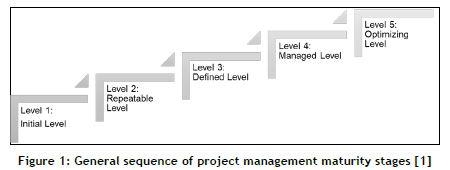
The PMS-PMMM is widely recognised, as the model's two-dimensional evaluation framework is derived from highly reputable institutions, which enhances the credibility of adopting the model [8,9]. One dimension is derived from the five levels of maturity of the Software Engineering Institute's (SEI) CMM. The other dimension is the Project Management Institute's (PMI) PMBOK® [16] knowledge areas, which are linked to the maturity levels. The widely recognised structure of the PMS-PMMM can be regarded as a strength, as it provides proper guidance on how to establish the current level of project management maturity for different knowledge areas [9]. Consequently, areas for improvement can easily be identified, enabling even less mature organisations to apply the model [9]. However, it could be argued that the PMS-PMMM structure is too rigid for a specific project environment, which would then make other PMMMs, such as KPMMM, more attractive, as they allow organisations to develop or customise their own methodology to assess project management maturity [2]. The PMS-PMMM framework was used in this study to establish the project management maturity of the case under consideration.
2.3. Project management knowledge areas
We are aware that a seventh edition of the PMBOK® was published in 2021, and that this edition is not based on knowledge areas. However, the PMMMs were developed using the knowledge areas covered in previous editions. Therefore, for the purposes of this study, we refer to the sixth edition of the PMBOK®.
The PMBOK® [16] was developed by the PMI, and has evolved over the years to cover 10 knowledge areas that facilitate best practices in the field of project management. As the PMBOK® provides best practice principles for the different project management knowledge areas, there is a general consensus that the application of these tools and techniques in projects should promote project success. The PMBOK® is a useful foundation to design methodologies, policies, and procedures. The 10 knowledge areas are listed in Figure 2.
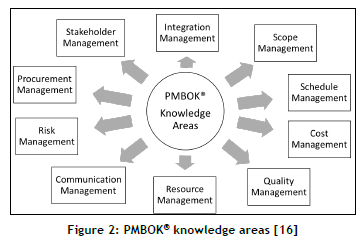
2.4. Project success
Different stakeholders define project success differently, subject to the project and organisational context [6,17,18,19]. Ika [20] agrees that no single definition exists for project success, but rather only perceived project success as defined by the range of project stakeholders. Marnewick [18] and Murambiwa and Barry [4] state that project success focuses on the end-product delivered by the project, and that project success is therefore highly reliant on customer satisfaction. In this study, perceived project success was evaluated.
Project success can be measured against the triple point constraint, which is based on cost, time, and quality [21]. The triple point constraint, also called 'the iron triangle', is a widely recognised tool used to measure project success [18,21]. A project is defined as successful when the project is finished on schedule and within budget to the correct quality, as agreed between all stakeholders [2,4,18]. Pollack, Helm and Adler [21] conducted a study using scientometric research techniques to understand the relationship and importance of key project management success concepts and to understand how the triple point constraint is still relevant. The study found significant links between cost, time, and quality, and confirmed the relevance of still applying the triple point constraint in project management today. However, the PMI [16] also regards project scope as a traditional metric to measure project success in addition to the triple point constraint's project cost, schedule, and quality deliverables. Furthermore, the PMI [16] advises that an integrated scope-schedule-cost plan should form the basis against which project performance is measured using earned value analysis.
Project deliverables as perceived by the interviewees were therefore categorised as follows in this study [2,15]:
- Failed: A project that is never completed or that fails to meet the project scope or any quality requirements contractually agreed between the customer and the project manager.
- Challenged: A project that is completed but is delivered late or over budget. Furthermore, the project may be deemed 'challenged' if not all project scope and quality requirements are met as contractually agreed between the customer and the project manager.
- Successful: A project that is delivered on schedule and within budget. The project also meets all scope and quality requirements as contractually agreed between the customer and the project manager.
2.5. Studies conducted on project management maturity and project success
Table 1 below summarises the main findings and recommendations by the authors of studies relevant to this research.
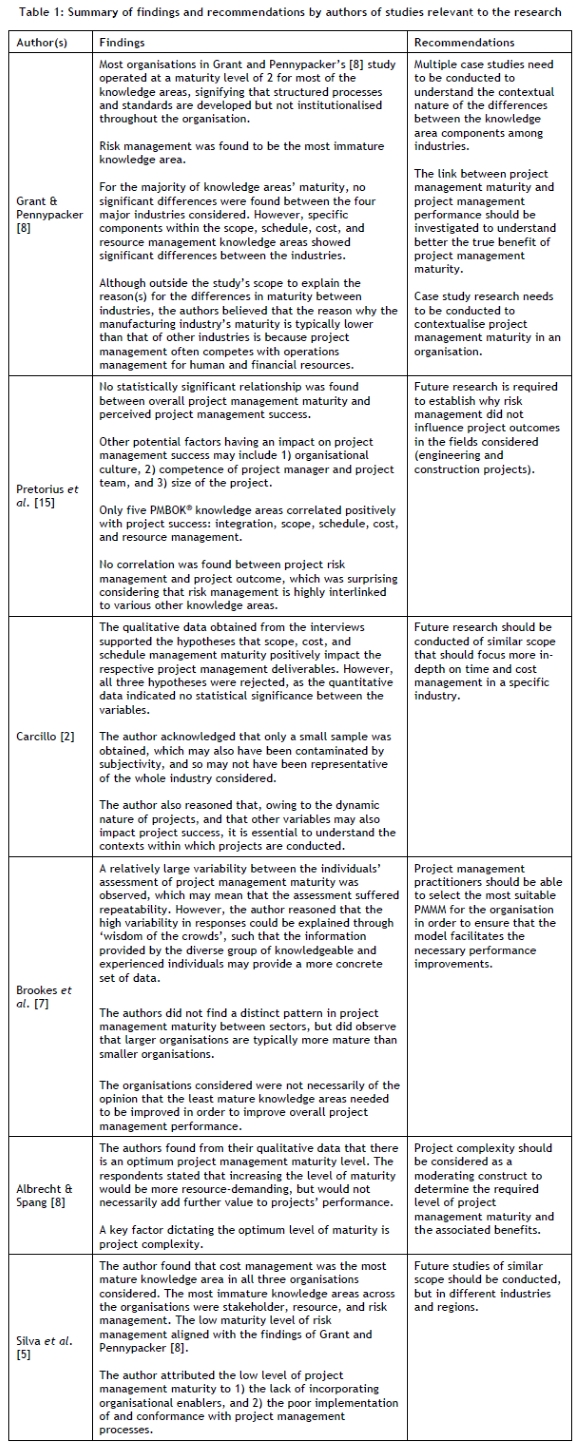
3. PROPOSITIONS AND CONCEPTUAL MODEL
Although PMBOK® discusses 10 knowledge areas, we investigated the project scope, cost, schedule, and quality management knowledge areas. Cost, schedule, and quality management constitute the three points of the triple point constraint, and the PMI considers scope an important aspect in measuring project success. However, it is acknowledged that the other knowledge areas could also impact the project management deliverables being considered; however, this did not form part of this study's scope. The following five propositions were developed to link project management maturity to project success:
P1: The higher the level of an organisation's project scope management maturity, the higher its likelihood of achieving its scope deliverables.
P2: The higher the level of an organisation's project cost management maturity, the higher its likelihood of achieving its cost deliverables.
P3: The higher the level of an organisation's project schedule management maturity, the higher its likelihood of achieving its schedule deliverables.
P4: The higher the level of an organisation's project quality management maturity, the higher its likelihood of achieving its quality deliverables.
P5: The higher the level of an organisation's project management maturity, the higher its likelihood of achieving perceived project success.
The propositions listed above are presented diagrammatically in Figure 3.
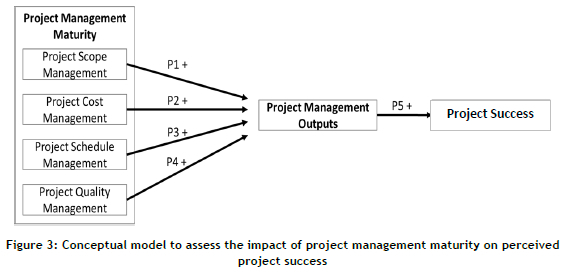
4. RESEARCH DESIGN
A single case study design was selected to conduct an in-depth assessment of the research phenomenon in a real-life context over which the researcher had no control [22,23]. Owing to the limited knowledge of the research phenomenon and the dynamic field in which projects are conducted, as discussed by Backlund et al. [1] and Murambiwa and Barry [4], it is important to evaluate the case in its environment [24,25].
The case study protocol used a similar approach to the process used by Brookes et al. [7]. Their process included: 1) initial engagement with the case organisation; 2) data collection; and 3) data analysis. The primary research data was collected via semi-structured interviews, and was triangulated with secondary textual data obtained by the case organisation. The semi-structured interview questions originated from the PMS-PMMM framework. Five project management practitioners were interviewed in person. The interviews were recorded and transcribed using Microsoft Teams. All the interviewees had an engineering background, and their experience ranged from one to seven years in the organisation's project department.
The primary and secondary data was imported into a computer-aided qualitative data analysis software package, and was then analysed using thematic analysis. Thematic analysis is a widely acknowledged technique that is used to identify, analyse, and report themes in qualitative research [26,27]. A deductive coding approach was adopted in which most of the generated codes came from a predefined set of codes identified during the literature review. Data saturation was achieved to some extent in the five interviews that were conducted. However, some unique information also emerged from the individual interviews.
The research was approved by the Ethics Committee of the Faculty of Engineering, the Built Environment and Information Technology at the University of Pretoria. Informed consent was obtained from all participants. Interview participation was conducted on a voluntary basis. The participants' identities were kept anonymous and, similar to Carcillo's [2] study, only aggregated data is reported. Before conducting the interviews, permission was sought from the interviewees to record the session. No incentives were issued to the participants. Member checking, a standard practice, was used: all interviewees were given the opportunity to review the interview findings to ensure that the interview data was not misinterpreted.
Construct validity was achieved by using well-defined constructs and multiple sources of evidence that converged through data triangulation [24,25]. As described in the previous paragraph, internal validity was achieved through member checking. The tactics used to ensure that reliability was achieved included establishing and following a case study protocol and maintaining a chain of evidence.
5. RESULTS AND DISCUSSION
5.1. Establishing project management maturity
The project management maturity level was established on the basis of the PMS-PMMM assessment framework. The maturity levels of each of the four PMBOK® knowledge areas (scope, schedule, cost, and quality) were assessed and rated by triangulating the data collected from the semi-structured interviews with the secondary textual data provided by the case organisation. The results are presented in Figure 4. The maturity of each knowledge area presented in Figure 4.b was taken as the average between the primary and secondary data shown in Figure 4.a.
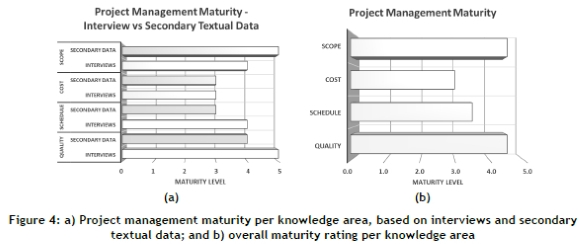
Project scope management maturity, based on the primary and secondary data, was determined to be at levels 4 and 5 respectively (Fig. 4.a.), resulting in an overall project scope maturity level of 4.5 (Fig. 4.b.) Although the secondary textual data indicated that effectiveness and efficiency metrics govern the scope decision-making process - that is, scope maturity level 5 - this was not made clear during the interviews. Nevertheless, both the primary and the secondary data indicated that project scope management processes are used on all projects, irrespective of size, which translates to a maturity level of 4. A project scope maturity level of 4.5 indicates not only that project scope management is structured and standardised, but also that the processes are managed.
Project cost management maturity, based on both the primary and the secondary data, indicated a project cost management maturity level of 3 (Fig. 4.a). Thus the overall project cost maturity of the organisation was determined to be at level 3 (Fig. 4.b.). The primary data, in alignment with the secondary textual data, indicated that structured processes for cost estimation and budgeting exist that are also an organisational standard and are applied to most projects.
Based on the primary and secondary data, project schedule management maturity was determined to be at level 4 and 3 respectively (Fig. 4.a), therefore resulting in an overall project schedule maturity level of 3.5 (Fig. 4.b). The primary data indicated that project schedule management uses historical data to forecast future performance, translating into a project schedule maturity level of 4 (Fig 4.a). This was not evident in the secondary textual data. However, both the primary and the secondary textual data indicated that most projects document and use schedule management processes and that inter-project dependencies are considered in project schedule management.
Project quality management maturity was determined to be at level 4 and 5 (Fig. 4.a), resulting in an average project quality maturity level of 4.5 (Fig 4.b). According to the primary data, the quality processes include documenting lessons learned and feeding improvements back into the process, translating into a quality maturity level of 5. The secondary textual data was rated at a maturity of 4, as the available data could not show how improvements to quality management are incorporated into the system. However, both data sources showed that a dedicated technical lead coordinates quality standards and assurance, and that quality processes are applied to all projects. A maturity level of 4.5 indicates that all projects are required to use quality standard processes and that quality standards and assurance are coordinated.
Project scope management and project quality management were determined to be the most mature project management knowledge areas. Similar to Brookes et al. [7], there was variability between the respondents' assessments of the project management maturity levels, which places the reliability of the maturity assessment under scrutiny, as repeatability is essential. However, in line with Brookes et al. [7] and Surowiecki [28], it should be acknowledged that the range of the interviewees' experience and knowledge may have reflected the 'wisdom of the crowds' phenomenon. The aggregated data gathered from the interviews may provide a more concrete set of information, as the group of individuals have their own personal and local knowledge. Brookes et al. [7] explained that reliability was achieved through the 'wisdom of the crowds' to derive a reliable maturity rating for each of the evaluated knowledge areas.
5.2. Perceived project success
5.2.1. Factors having an impact on project management outcomes
Five themes were identified during the coding of factors that had an impact on project deliverables as perceived by the interviewees. The five themes were organisational support, external environment, project characteristics, project management maturity, and project team characteristics. 'Organisational support' refers not only to support from top management, but also to the support from other cross-functional departments. 'External environment factors' include but are not limited to market conditions, weather conditions, and socio-political factors. 'Project characteristics' include the project environment, its complexity, and its size. 'Project management maturity', as described in the literature review, refers to established project management policies, procedures, and methodologies that constitute explicit knowledge for project management practitioners. 'Characteristics of the project team' (in which 'team' includes both the project management team and contractors) refer to team and individual experience, tacit knowledge, soft skills, leadership skills, and morale. Table 2 illustrates the extent to which each factor had an impact on each of the project deliverables as perceived by the interviewees.

It was observed that the two most significant factors that hindered projects in achieving their project deliverables were, first, project management maturity and, second, the external environment. It was acknowledged that project characteristics also had an impact on each of the project deliverables to some extent. Organisational support was perceived to have only a limited impact on cost and schedule deliverables, while characteristics of the project team seemed to only have a small impact on project scope and schedule deliverables.
5.2.2. Probability of achieving project deliverables based on project size
The respondents were asked whether there is a difference in probability between small, medium, and major projects achieving their scope, cost, schedule, and quality deliverables. The results are presented in Table 3.

The majority of interviewees (60%) stated that there is no difference in probability between small, medium, and major projects in achieving their scope deliverables. In their opinion, all projects, irrespective of size, undergo the same scope management methodology to ensure that they achieve their scope deliverables. Furthermore, all projects are subject to risks associated with external factors, irrespective of their size. On the other hand, some respondents (40%) reasoned that smaller projects are less complex in scope, and therefore have a higher probability of achieving their scope deliverables than larger, more complex projects.
The majority of informants (80%) noted that there is a definite difference in achieving project cost deliverables, based on project size. Smaller projects with a smaller scope typically have a more accurate cost estimation and budgeting in place than larger, more complex projects where the scope is not clearly defined. The more accurate cost estimation and budgeting of smaller projects then typically enables the project manager to control the costs more effectively.
A total of 40% of the respondents affirmed that larger projects are typically more complex and resource-demanding, and are therefore more exposed to schedule-related risks. However, 20% of the interviewees noted that project schedules are adversely impacted irrespective of project size; even smaller, less complex projects are also exposed to external factors that may adversely impact a project's schedule. The majority of the interviewees (60%) affirmed that attaining quality deliverables is mandatory, irrespective of project size. If quality deviations are observed during project execution, they are rectified through a well-established quality control procedure.
5.3. Impact of project management maturity on perceived project success
Table 4 shows the impact of the level of the knowledge areas' maturity and overall project management maturity on achieving the associated deliverables and overall project success, respectively, as perceived by the interviewees.
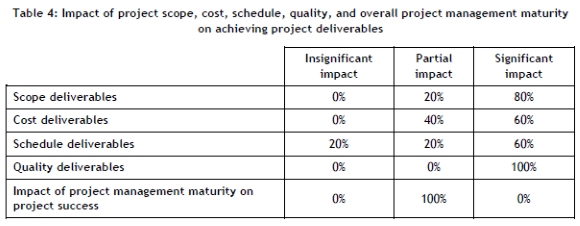
The majority of interviewees (80%) affirmed that the level of project management maturity plays a significant role in projects' achieving their scope deliverables. The project scope management processes in place in the case being considered promote the successful delivery of projects' scope deliverables. The projects undergo a comprehensive approval process through different levels of authorisation. The project manager, therefore, needs to have a good understanding of the scope in order to gain the necessary organisational support, which is a prerequisite for a project to achieve its scope deliverables. Having a well-structured scope management process in place is also essential, as it forms the basis for schedule, cost, and quality management planning processes. However, in one interview it was argued that scope project management maturity only contributes to a limited extent to projects' achieving their scope deliverables owing to the external factors to which projects are exposed.
P2: The higher the level of an organisation's project cost management maturity, the higher its likelihood of achieving its cost deliverables.
The majority of the informants (60%) stated that a higher level of project cost management maturity contributes positively to project cost deliverables. It was apparent that, if cost estimation, budgeting, and cost control processes are not established and performed diligently, then a project can easily overrun its budget. However, it was also stated that, in the dynamic environment in which projects are executed, relying on project cost management maturity alone will not guarantee that a project achieves its cost deliverables.
P3: The higher the level of an organisation's project schedule management maturity, the higher its likelihood of achieving its schedule deliverables.
Most of the respondents (60%) reported that a higher level of project schedule management maturity promotes the successful delivery of project schedule deliverables. Emphasis was placed on the planning process group's processes in line with PMBOK®. However, 40 per cent of the respondents said that the project schedule management maturity level does not necessarily contribute to project schedule deliverables because of the production environment in which projects are executed. This is in addition to other external factors, which introduce all types of schedule-related risk that cannot be fully accounted for in the documentation of the project's schedule management process.
P4: The higher the level of an organisation's project quality management maturity, the higher its likelihood of achieving its quality deliverables.
All the respondents were of the opinion that a higher level of project quality management maturity contributes to the successful delivery of project quality deliverables. All stated that the necessary quality standards are in place, which are mandatory and are controlled for all projects in line with the documented plan. Emphasis was placed on the plan quality management process, stating the importance of identifying and agreeing what and how quality deliverables will be managed and controlled.
P5: The higher the level of an organisation's project management maturity, the higher its likelihood of achieving perceived project success.
There was consensus that higher levels of project management maturity only have a limited impact on perceived project success. All the respondents did acknowledge the importance of project management maturity and how it can increase the probability of projects achieving overall perceived project success. However, all the respondents noted that merely having mature project management processes does not necessarily ensure project success. Reference was made to external factors adversely having an impact on the outcomes of project deliverables, with specific reference to fluctuating commodity prices, foreign exchange rates, and geopolitical instability, which hinder project performance in various ways. It was also apparent that project management often competes with operations management. Considering the case organisation's core function, operations management generally takes precedence over project management. This is similar to what Grant and Pennypacker [8] argued in their study. In agreement with Anantatmula and Rad [6], it was also mentioned that each project is unique, and that adopting a structured project management methodology that is too rigid may adversely impact innovation, flexibility, and consequently project performance, especially in an agile project environment. Furthermore, effective stakeholder, communication, and resources management was also identified as factors having an impact on perceived project success. However, the respondents referred more to the tacit knowledge gained from experience and soft skills than to the explicit knowledge covered in project management policies and procedures. Although the experience and soft skills of the project manager, project team, or other key role players did not come up as a factor having an impact on the individual deliverables of the specific knowledge areas studied here (scope, cost, schedule, and quality), it does appear that tacit knowledge and soft skills may have overarching importance in achieving overall perceived project success.
6. CONCLUSIONS AND RECOMMENDATIONS
6.1. Conclusion
6.1.1. Establishing project management maturity
Project scope and quality management were found to be the most mature with a maturity level of 4.5, while project schedule and cost management were found to have a maturity of 3.5 and 3 respectively.
The variability in the data obtained from the interviewees is justified through the 'wisdom of the crowds', as explained by Brookes et al. [7], such that a more accurate set of aggregated data was obtained from the group of experienced and knowledgeable project management practitioners.
6.1.2. Factors having an impact on project management outcomes
Project management maturity and the external environment were the two most significant factors keeping projects from achieving their project management deliverables. It was acknowledged that project characteristics also had an impact on each of the four project management deliverables considered in this study. Organisational support was perceived to have only a limited impact on cost and schedule deliverables, while the characteristics of the project team seemed to only have a small impact on project scope and schedule deliverables.
6.1.3. Impact of project management maturity on perceived project success
By qualitatively assessing the impact of project management maturity on project success as perceived by the interviewees, the main conclusions are the following:
- Project scope management maturity plays an important role in projects achieving their scope deliverables.
- A high maturity level in project scope management is essential, as it lays the foundation for project schedule, cost, and quality management.
- A higher level of project cost management maturity contributes positively to project cost deliverables.
- A higher level of project schedule management maturity promotes the successful delivery of project schedule deliverables.
- A higher level of project quality management maturity is deemed to play a dominating role in the successful delivery of project quality deliverables.
- Higher levels of project management maturity contribute to perceived project success, but only to a limited extent. Ample reference was made to external factors having an adverse impact on the outcomes of project deliverables.
6.1.4. Contributions of the study
The study addresses a gap in the body of knowledge pertaining to research on the impact of project management maturity on project success in the mining industry in Southern Africa. Previous studies of similar scope mainly focused on the information technology, services, and construction industries, while little research has been conducted on the mining industry. Last, while several studies on project management maturity have been conducted in developed countries, this study contributes to research in developing countries.
6.2. Limitations and recommendations for future research
6.2.1. Limitations of the study
The study took place in a developing country in Southern Africa. It would be interesting to compare these results with research from a developed country. In addition, this research focused on a single case study in one mining organisation. The small sample size could lead to the findings not being representative of the broader population.
6.2.2. Recommendations
The study identifies gaps in the understanding of project management maturity's role in achieving project success, providing a basis for future research to explore other contributing factors and their interplay with maturity levels. It is recommended that research of similar scope be conducted by using a multiple-case study in the mining environment, which is known to be dominated by operations management. By being able to perform replication logic, a multiple-case study should enhance the research's external validity. Future research may also include conducting an exploratory study to evaluate the suitability of the different PMMMs in a production-orientated environment.
This study provides mining operations and other organisations with specific insights into the importance of project management maturity across key knowledge areas. Organisations could use these findings to develop targeted strategies for enhancing their project management processes.
REFERENCES
[1] Backlund, F., Chronéer, D. & Sundqvist, E. 2014. Project management maturity models - A critical review: A case study within Swedish engineering and construction organisations. Procedia - Social and Behavioural Science, 119(2014), pp 837-846. [ Links ]
[2] Carcillo, A.J. 2012. The impact of project management maturity upon IT/IS project management outcomes. Doctor of Business Administration dissertation, Wilmington University, New Castle, Delaware [ Links ]
[3] Hatamleh, M.T., Moynihan, G.P., Alzarrad, M.A. & Batson, R.G. 2020. Using the project management maturity models to evaluate organisational implementation in Jordan: A case study, International Journal of Construction Project Management, 12(1), pp 17-28. [ Links ]
[4] Murambiwa, T.M. & Barry, M.L. 2012. An investigation into the relationship between project management maturity and project performance in the telecommunications industry in Zimbabwe. Proceedings of the 2012 IEEE IEEEM, pp 812-816. [ Links ]
[5] Silva, R., Duarte, N., Barros, T. & Fernandes, G. 2019. Project management maturity: Case study analysis using OPM3 model in the manufacturing industry. IEEE International Conference on Engineering, Technology and Innovation (ICE/ITMC), pp 1-8. IEEE [ Links ]
[6] Anantatmula, V. & Rad, P. 2013. Linkages among project maturity, PMO and project success. 2013 International Conference on Engineering, Technology and Innovation (ICE) & IEEE International Technology Management Conference, pp 1-12. IEEE. [ Links ]
[7] Brookes, N., Butler, M., Dey, P. & Clark, R. 2014. The use of maturity models in improving project management performance. International Journal of Managing Projects in Business, 7(2), pp 231-246. [ Links ]
[8] Grant, K.P. & Pennypacker, J.S. 2006. Project management maturity: An assessment of project management capabilities among and between selected industries. IEEE Transactions on Engineering Management, 52(1), pp 59-68. [ Links ]
[9] Gomes, C.F. & De Souza, T.F. 2015. Assessment of maturity in project management: A bibliometric study of the main models. Information Technology and Quantitative Management, 55, pp 92-101. [ Links ]
[10] Albrecht, J.C. & Spang, K. 2014. Linking the benefits of project management maturity to project complexity: Insights from a multiple case study. International Journal of Managing Projects in Business, 7(2), pp 285-301. [ Links ]
[11] Pretorius, S., Steyn, H. & Bond-Barnard, T.J. 2022. The relationship between project management maturity and project success. Journal of Modern Project Management, 10(1), pp 219-231. [ Links ]
[12] Malik, V., Haryono, I. & Pratami, D. 2018. The utilization of project management maturity models in enhancing project management capabilities: Case study of a project-based organization in Indonesia. The 2nd International Conference on Family Business & Entrepreneurship, Bali, Indonesia. [ Links ]
[13] Ibbs, C.W. & Kwak, Y.H. 2000. Assessing project management maturity. Project Management Journal, 31(1), pp 32-43. [ Links ]
[14] Nicolas, J.M. & Steyn, H. 2021. Project management for engineering, business and technology, 6th edition. Routledge, Taylor & Francis. London and New York. [ Links ]
[15] Pretorius, S., Steyn, H. & Jordaan, J.C. 2012. Project management maturity and project management success in the engineering and construction industries in Southern Africa. South African Journal of Industrial Engineering, 23(3), pp 1-12. [ Links ]
[16] Project Management Institute (PMI). 2017. A guide to the project management body of knowledge, 6th edition. Project Management Institute. Newton Square, Pennsylvania. [ Links ]
[17] Jugdev, K. & Müller, R. 2005. A retrospective look at our evolving understanding of project success. Project Management Journal, 36(4), pp 19-31. [ Links ]
[18] Elof, M., Labuschagne, L., Marnewick, C. (ed.), Steyn, H. & Tobin. P. 2013. Prosperus report: Project management maturity vs project outcomes in Africa. Project Management South Africa, South Africa. [ Links ]
[19] Rad, P.F. 2003. Project success attributes. Cost Engineering, 45(4), pp 23-29. [ Links ]
[20] Ika, L.A. 2009. Project success as a topic in project management journals. Project Management Journal, 40(4), pp 6-19. [ Links ]
[21] Pollack, J., Helm, J. & Adler, D. 2018. What is the iron triangle, and how has it changed? International Journal of Management Projects in Business, 11(2), pp 527-547. [ Links ]
[22] Rowley, J. 2002. Using case studies in research. Management Research News, 25(1), pp 16-2. [ Links ]
[23] Yin, R.K. 2009a. The case study crisis: Some answers. Administrative Science Quarterly, 26(1), pp 58-65. [ Links ]
[24] Yin, R.K. 2009b. Case study research: Design and methods. 2nd edition. Sage. Thousand Oaks. [ Links ]
[25] Eisenhardt, K.M. 2010. Creating insights from case study research. Stanford Technology Ventures Program, Plenary, July 2010, p 106. [ Links ]
[26] Ali, F. & Ghasemy, M. 2019. Advanced qualitative data analysis using Atlas.ti. College of Hospitality and Tourism Leadership, University of South Carolina. Columbia, South Carolina. [ Links ]
[27] Braun, V. & Clarke, V. 2006. Using thematic analysis in psychology. Qualitative Research in Psychology, 3(2), pp 77-101. [ Links ]
[28] Surowiecki, J. 2004. The wisdom of crowds. Doubleday, Anchor. New York. [ Links ]
Submitted by authors 12 Jun 2023
Accepted for publication 9 Jul 2024
Available online 30 Aug 2024
* Corresponding author suzaan.pretorius@up.ac.za
ORCID® identifiers
E .Burger
https://orcid.org/0009-0006-8625-9970
S. Pretorius
https://orcid.org/0000-0003-4612-9558
H. Steyn
https://orcid.org/0000-0002-5913-6354













